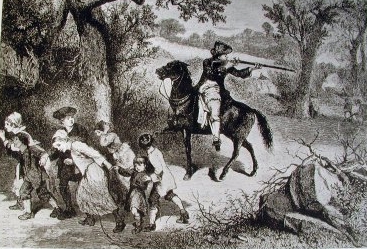 FROM
WHICH HANNAH DUSTON WAS CARRIED AWAY BY THE INDIANS
FROM
WHICH HANNAH DUSTON WAS CARRIED AWAY BY THE INDIANS
 FROM
WHICH HANNAH DUSTON WAS CARRIED AWAY BY THE INDIANS
FROM
WHICH HANNAH DUSTON WAS CARRIED AWAY BY THE INDIANS
The attention of visitors to Haverhill, Massachusetts, is attracted to a great granite boulder set in a place of honor in the old town. When they ask about it they are told the story of Hannah Duston, heroine.
Thomas and Hannah Duston were married in 1677, and at once built a humble house of imported brick on the spot where the boulder now stands. Frequently one of the- bricks is uncovered on the site; those who examine it marvel at the thought of the building material brought across the sea.
Later Thomas Duston uncovered deposits of clay near his home which led him to make experiments in brick making. He was so successful that his product was in demand; villagers said that the Haverhill bricks were fully as good as those brought from England.
Strong building material was needed, for hostile Indians were all about. In order to afford protection against them, Mr. Duston determined to build a new house, which should serve as a garrison in time of danger. By the village authorities he was appointed keeper of the garrison, as this commission shows :
" To Thomas Duston, upon the settlement of garrisons. You being appointed master of the garrison at your house, you are hereby in his Majesty's name, required to see that a good watch is kept at your garrison both by night and by day by those persons hereafter named who are to be under your command and inspection in building or repairing your garrison, and if any person refuse or neglect their duty, you are accordingly required to make return of the same, under your hand to the Committee of militia in Haverhill."
The new house was well under way when this command was given. As it is still standing, it is possible to tell of it's construction. A Haverhill writer says that " white oak, which is today well preserved, was used in its massive framework, and the floor and roof timbers are put together with great wooden pins. In early days the windows swung outward, and the glass was very thick, and set into the frames with lead."
 On
March 15, 1697, the watching Indians decided that their opportunity had come to
attack the village. They knew that if they waited for the completion of the new
garrison, there would be little chance of success. So they struck at once.
On
March 15, 1697, the watching Indians decided that their opportunity had come to
attack the village. They knew that if they waited for the completion of the new
garrison, there would be little chance of success. So they struck at once.